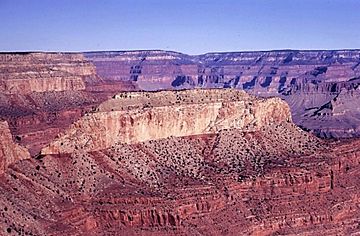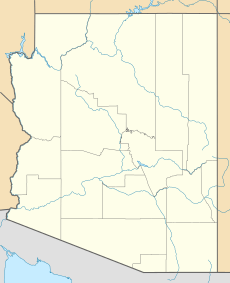Castor Temple facts for kids
Quick facts for kids Castor Temple |
|
|---|---|

Southeast aspect, from Jicarilla Point
|
|
| Highest point | |
| Elevation | 6,221 ft (1,896 m) |
| Prominence | 581 ft (177 m) |
| Isolation | 1.07 mi (1.72 km) |
| Parent peak | Pollux Temple (6,251 ft) |
| Geography | |
| Location | Grand Canyon National Park Coconino County, Arizona, US |
| Parent range | Coconino Plateau Colorado Plateau |
| Topo map | USGS Havasupai Point |
| Type of rock | limestone, sandstone, mudstone |
| Climbing | |
| First ascent | 1971 |
| Easiest route | class 4 climbing |
Castor Temple is a mountain peak in the amazing Grand Canyon in northern Arizona, United States. It stands tall at 6,221 feet (1,896 meters) above sea level. This impressive summit is located about 11 miles west-northwest of Grand Canyon Village. It's also less than one mile north of Piute Point.
Castor Temple is named after Castor, a character from Greek mythology. Castor was the twin half-brother of Pollux. Interestingly, another nearby peak is called Pollux Temple. In ancient Rome, the Temple of Castor and Pollux was close to the Temple of Vesta. In the Grand Canyon, Vesta Temple is also nearby, less than four miles to the southeast. Clarence Dutton started the tradition of naming Grand Canyon features after gods and goddesses. The name "Castor Temple" was officially recognized in 1964.
The area around Castor Temple has a Cold semi-arid climate. This means it's usually dry with cold winters. You can reach this peak by following the Tonto Trail. The first time anyone successfully climbed to the top of Castor Temple was on April 19, 1971. The climbers were Donald Davis and Alan Doty.
What is Castor Temple Like?
Castor Temple rises dramatically from the landscape. It towers over 3,800 feet (1,160 meters) above the Colorado River. This huge height difference happens over just two miles. It's a truly impressive sight!
How Was Castor Temple Formed?
Castor Temple is made up of several layers of rock. These layers were formed over millions of years. The very top of the peak has a thin layer of rock called the Brady Canyon Member. This is part of the Toroweap Formation. Below it is the Seligman Member, also from the Toroweap Formation.
Layers of Rock
Underneath these top layers, you can see a bright, cream-colored rock. This is the Coconino Sandstone. It forms steep cliffs. This sandstone is one of the youngest rock layers in the Grand Canyon. It was formed about 265 million years ago from ancient sand dunes.
Below the Coconino Sandstone are other layers:
- The reddish Hermit Formation.
- The red ledges of Esplanade Sandstone.
- The Wescogame Formation and Manakacha Formation. These are part of the Supai Group.
Even further down, you'll find the cliff-forming Redwall Limestone. This rock layer is from the Mississippian period. Finally, at the very bottom, are the rocks of the Cambrian Tonto Group. Rainwater from Castor Temple flows northeast into the Colorado River. It travels through Turquoise and Sapphire Canyons.



